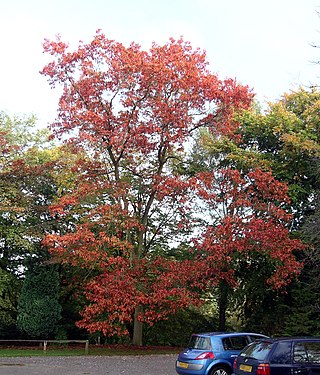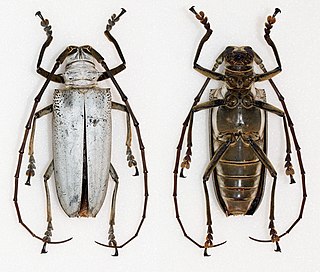
Quercus rubra, the northern red oak, is an oak tree in the red oak group. It is a native of North America, in the eastern and central United States and southeast and south-central Canada. It has been introduced to small areas in Western Europe, where it can frequently be seen cultivated in gardens and parks. It prefers good soil that is slightly acidic. Often simply called red oak, northern red oak is so named to distinguish it from southern red oak (Q. falcata), also known as the Spanish oak. Northern Red Oak is sometimes called champion oak.

Ulmus rubra, the slippery elm, is a species of elm native to eastern North America. Other common names include red elm, gray elm, soft elm, moose elm, and Indian elm.
The elm cultivar Ulmus 'Rubra' was reputedly cloned from a tree found by Vilmorin in a wood near Verrières-le-Buisson in the 1830s. It was listed in the 1869 Catalogue of Simon-Louis, Metz, France, as Ulmus campestris rubra, and by Planchon in de Candolle's Prodromus Systematis Naturalis Regni Vegetabilis (1873) as Ulmus libero-rubra: 'Orme à liber rouge' [:elm with red inner bark]. Elwes and Henry (1913) and Bean (1936) listed it as Ulmus montana [:U. glabraHuds.] var. libro-rubro, the former stating that the tree appeared "identical" to Simon-Louis's Ulmus campestris rubra. A specimen in the Zuiderpark, The Hague, was identified in 1940 as a wych elm cultivar, U. glabraHuds.libero rubro.
The hybrid elm cultivar Ulmus × intermedia 'Rosehill' is an American hybrid cultivar originally raised by the Rose Hill Nurseries of Kansas City, Missouri, as Ulmus 'Rose Hill', without species names, from a selection of Ulmus pumila × Ulmus rubra seedlings made in 1951.

Festuca rubra is a species of grass known by the common name red fescue or creeping red fescue. It is widespread across much of the Northern Hemisphere and can tolerate many habitats and climates. It is best adapted to well-drained soils in cool, temperate climates; it prefers shadier areas and is often planted for its shade tolerance. Wild animals browse it, but it has not been important for domestic forage due to low productivity and palatability. It is also an ornamental plant for gardens.

Plumeria rubra is a deciduous plant species belonging to the genus Plumeria. Originally native to Mexico, Central America, Colombia and Venezuela, it has been widely cultivated in subtropical and tropical climates worldwide and is a popular garden and park plant, as well as being used in temples and cemeteries. It grows as a spreading tree to 7–8 m (23–26 ft) high and wide, and is flushed with fragrant flowers of shades of pink, white and yellow over the summer and autumn.
Ulmus ellipticaKoch is a disputed species of elm, native to the Caucasus, where Koch reported that it formed extensive woods, and ranging north to southern Ukraine. The tree is said to be closely related to U. glabra, but to resemble U. rubra in its samara. Many authorities consider U. ellipticaKoch just a regional form of U. glabra, though Henry, Bean and Krüssman list the Caucasus tree as a species in its own right. U. ellipticaKoch is distinguished from U. scabraMill. [:U. glabra] in some Armenian and Russian plant lists.

The blacklip abalone, Haliotis rubra, is an Australian species of large, edible sea snail, a marine gastropod mollusk in the family Haliotidae, the abalones.

Rosenbergia is a genus of longhorn beetles in the subfamily Lamiinae, close to the genus Batocera.

Rosenbergia rufolineata is a species of longhorn beetles in the subfamily Lamiinae.
Rosenbergia schmitti is a species of beetle in the family Cerambycidae. It was described by Rigout in 1981.
Rosenbergia dankersi is a species of beetle in the family Cerambycidae. It was described by Rigout in 2004.
Rosenbergia bismarckiana is a species of beetle in the family Cerambycidae. It was described by Kriesche in 1920.
Rosenbergia denserugata is a species of beetle in the family Cerambycidae. It was described by Breuning in 1936.
Rosenbergia freneyi is a species of beetle in the family Cerambycidae. It was described by Rigout in 1988.

Rosenbergia lactiflua is a species of beetle in the family Cerambycidae. It was described by Fairmaire in 1883. It is known from Papua New Guinea and Solomon Islands. It includes the varietas Rosenbergia lactiflua var. coerulescens.

Rosenbergia mandibularis is a species of beetle in the family Cerambycidae. It was described by Ritsema in 1881.

Rosenbergia straussi is a species of beetle in the family Cerambycidae. It was described by Gestro in 1876.
Rosenbergia vetusta is a species of beetle in the family Cerambycidae. It was described by Ritsema in 1881. It is known from Papua New Guinea.
Ulmus × intermediaElowsky is a natural hybrid elm occurring across Nebraska and several other Midwestern states, derived from the crossing of Ulmus rubra and Ulmus pumila. As Red Elm U. rubra is far less fertile, and highly susceptible to Dutch elm disease (:DED), it could eventually be hybridized out of existence by U. × intermedia. The hybrid was first reported from the wild in the Chicago region in 1950 and was provisionally named U. × nothaWilhelm & Ware in 1994.








